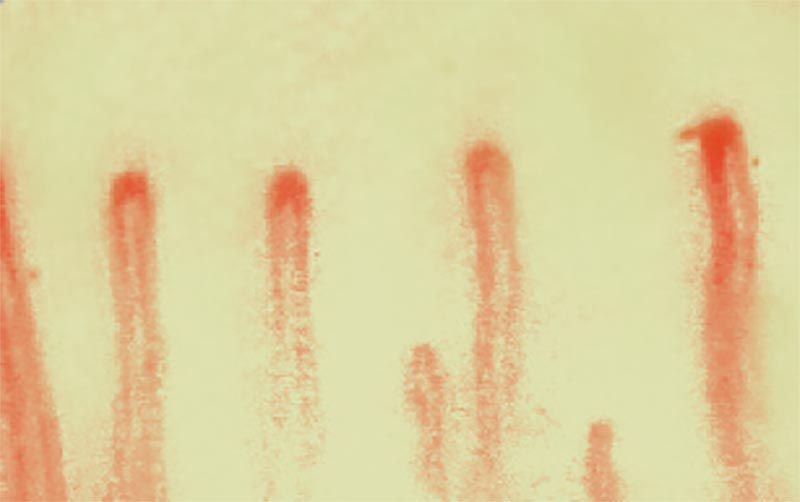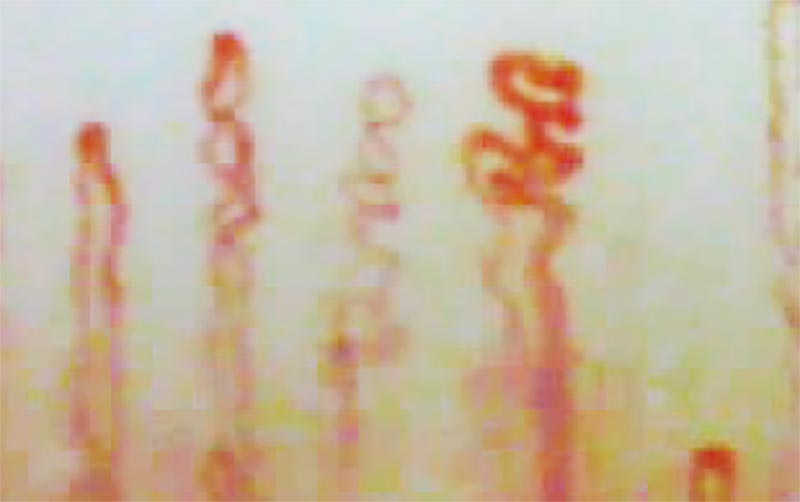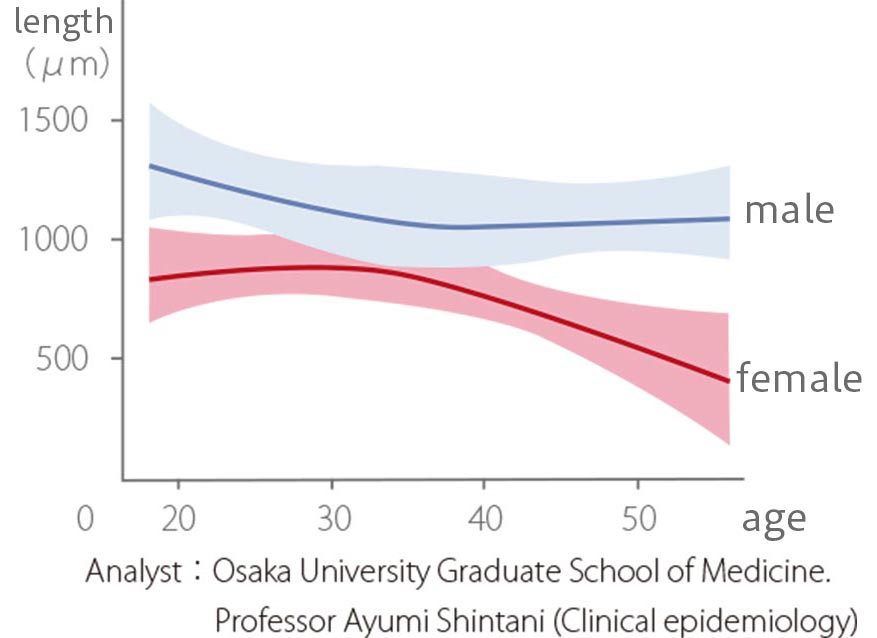About capillary
What is capillary analysis?
Capillary analysis monitors minute changes occurring within your body based on information concerning capillary length, thickness, and other factors.
In the past, despite research being done on observing capillary condition through the fingernail bed, capillary observation was primarily done through MRI and fundoscopic examination due to issues with individual differences and quantitation.
Aiming for a capillary analysis method that has zero burden on the body, unlike the previous methods that had a significant burden, AT has developed a kind of capillary analysis method that can observe capillaries in real time without pain using the fingertips.

Health capillaries

Unhealthy capillaries due to a disorderly lifestyle
Reasons for observing capillaries
Observing your capillaries means observing the condition of your own health.
 The capillaries supply the nutrients and oxygen we absorb on a regular basis throughout the body. They are a type of blood vessel that also plays a special role in expelling excess waste products from the body.
The capillaries supply the nutrients and oxygen we absorb on a regular basis throughout the body. They are a type of blood vessel that also plays a special role in expelling excess waste products from the body.
Capillaries account for 95% of the body’s blood vessels, with a total length of 100,000 km. It is essential to understand the minute changes occurring within your body by observing your capillaries.
Is there a difference between men and women in terms of capillaries?
 The graph on the right shows the results of an investigation on the correlation between capillary length, sex, and age (n = 150). Women tend to have shorter capillaries than men. From this graph, we can see that women have capillaries with a length that is roughly two-thirds of men. We can also see that capillary length decreases in men from their 20s and on due to the impact of desk work and other factors. Furthermore, we can see that capillary length decreases in women from their 30s and on due to the effects of hormones.
The graph on the right shows the results of an investigation on the correlation between capillary length, sex, and age (n = 150). Women tend to have shorter capillaries than men. From this graph, we can see that women have capillaries with a length that is roughly two-thirds of men. We can also see that capillary length decreases in men from their 20s and on due to the impact of desk work and other factors. Furthermore, we can see that capillary length decreases in women from their 30s and on due to the effects of hormones.
These differences that exist between men and women and by age have been understood thanks to our ability to convert capillary images into numerical form.
We expect that this new type of capillary research will lead to many other revelations going forward.
The underlying wish of blood vessels
Protect your health on your own, aim to be a Kekkan Bijin!!
Food (nutrition) Sleep (rest) Movement (exercise)
The above are the three basic components of promoting health. We can prevent illnesses by living a well-regulated lifestyle.
However, living such a lifestyle without acquiring the proper knowledge and acting on that knowledge can, conversely, lead to poor physical health. It is up to you to protect your own body.
We feel that, in recent years, people are suffering from the same kinds of illnesses due to pollution in food, water, air, and the overall environment. In other words, we are now in a time where it is easy to get sick. Therefore, we must promptly realize that we are in such a time and promote preventative habits. We must do so to protect those we love.
When will you start making efforts toward prevention?
The importance of understanding pre-symptomatic diseases and prevention
Mibyou, or pre-symptomatic disease, refers to the following conditions: not noticing symptoms but finding irregularities in examinations, and noticing symptoms but not finding irregularities in examinations.
 In 1998, the World Health Organization proposed the concept that health and illnesses are not two separate things, but rather one continuous thing. However, even before the 2000s, there was a concept in Asia of mibyou, or “pre-symptomatic disease,” which summarizes the condition before getting sick. Now, there is such a thing as pre-symptomatic disease studies, which refers to the science between health and illness. In fact, mibyou (Japanese for pre-symptomatic disease) has recently been recognized as a word shared throughout the world.
In 1998, the World Health Organization proposed the concept that health and illnesses are not two separate things, but rather one continuous thing. However, even before the 2000s, there was a concept in Asia of mibyou, or “pre-symptomatic disease,” which summarizes the condition before getting sick. Now, there is such a thing as pre-symptomatic disease studies, which refers to the science between health and illness. In fact, mibyou (Japanese for pre-symptomatic disease) has recently been recognized as a word shared throughout the world.
People do not contract major illnesses all of the sudden, without any advance warnings.
This means that depending on the stage of pre-symptomatic disease at which you notice changes occurring within yourself, as well as on the stage of pre-symptomatic disease at which you make improvements, you can prevent becoming sick. In fact, in China, doctors who can identify and treat pre-symptomatic disease are held in high regard.
With concern about Japan, which is said to be a country where illnesses occur often, there have been organizations that have been making efforts for roughly 10 years to be able to have people in Japan understand the significant meaning pre-symptomatic disease has, as well as to popularize the concept of pre-symptomatic disease and have it included in medical treatment systems.
We have been born in a time where it is easy for people to get sick, and many people are suffering from the same kind of illnesses. It is precisely in such times that we need Kekkan Bijin, a device that can detect pre-symptomatic disease.
A certain doctor we have spoken to has stated that each one of his cancer patients has said the same thing, “I did not think that cancer could happen to me.”
Also, while many people are concerned about metabolic syndrome, which is gathering attention as a major health worry for men in particular, these people are not sure what to do and when to do it. It is important for these people to understand the condition of their own bodies and improve their awareness toward preventing diseases.
Waste products accumulated within the body
Human beings eat food with their mouths and absorb nutrition to live.
However, food is composed of various substances and causes a wide variety of chemical reactions (metabolism) from when it enters the mouth and is chewed, to when it is digested, absorbed, and finally excreted. Human beings absorb the necessary substances from food as nutrition and excrete the unnecessary substances, called waste products, through exhalation, sweat, urination, and excrement.
For example, when we inhale, we take air into our bodies. At this time, a chemical reaction occurs where we take in the necessary substances (oxygen, etc.). Carbon dioxide is then created to compensate for the oxygen we absorbed. Carbon dioxide is not a necessary substance, so it is therefore passed out of the body when we exhale.
With a regular, healthy body, these kind of chemical reactions occur within the body smoothly in a cycle. However, as many aspects of the environment are being thrown off balance, the inside of our bodies is being thrown off balance as well. Accordingly, new types of diseases that we have not seen in the past are increasing at a rapid rate. For example, there are many people with allergy symptoms such as atopy. Experts are saying that such symptoms are the result of waste products being continuously accumulated within the body.
The substances that are passed out during the metabolic process are referred to as waste products. However, these are now not the only kind of waste products that exist. There are other waste products such as lactic acid, which is accumulated during weight training. Furthermore, with the progressively more polluted environment, hazardous metals are being accumulated within the body more and more from various places such as tap water, exhaust fumes, acid rain, seafood, and vegetables (soil). Some prime examples of these hazardous metals are cadmium, mercury, arsenic, aluminum, lead, and beryllium. It is believed that these waste products bring about various illness, speed up the aging process, and cause poor physical health.
When observing blood vessels and blood flow with Kekkan Bijin, there are some people whose blood vessels are extremely difficult to see. These kind of people often are extremely fatigued from busy jobs and have a high level of stress. They also tend to suffer from lack of sleep and allergy symptoms (atopy, pollen allergy). It is important for such people to make efforts to live a lifestyle that focuses on passing the accumulated waste products, chemical substances, and heavy metals out of their bodies.
